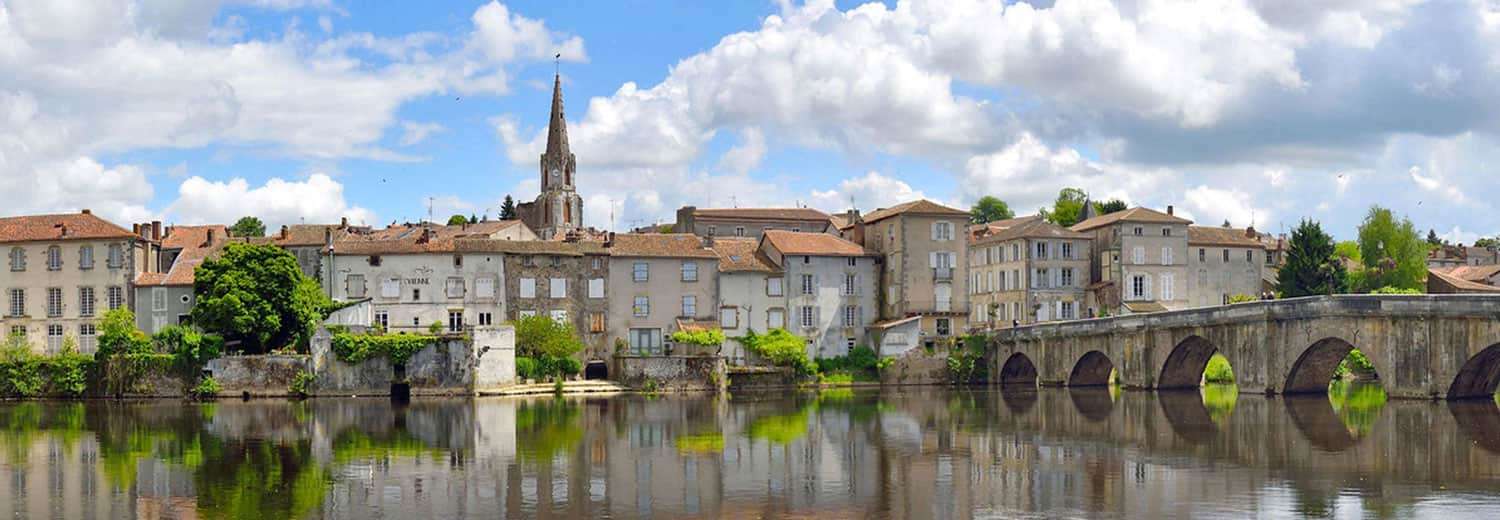GET A QUICK, FREE QUOTE
Rated 'Excellent'
on Trustpilot
ECMT International
Removals Permit
British Association
of Removers
Eco Friendly
Removals
Our Removals Service Includes…
For removals to and from Confolens.
Call Now 0808 175 1966
Confolens
A town steeped in history with many modern facilities and a global attitude
The new town of Confolens was created in 2016 with the merger of Confolens and its neighbour Saint-Germain-de-Confolens.
The town, which draws thousands of visitors with its annual music festival in August each year, sits where the Vienne and Goire rivers meet.
It is breathtakingly pretty, with many medieval buildings, a keep and two bridges. A real gem of the Charente department.
Nearby beauty sports include Chassenon and the Haute-Charente lakes, which offer watersports and sandy beaches.
Prices for the most gorgeous properties are low here, making it a very attractive prospect for holiday homes as well as incoming settlers.
Once known for its tanneries, the town features about 60 half timber buildings along the river where people used to make their living with leather goods.
Confolens also has a dungeon, fortifications from the Middle Ages and historic mansions – it is well worth a visit if you are considering a move to the Charente.
For over 60 years the town has drawn musicians from around the globe with its annual festival, which celebrates world music on a grand scale, with a whole fortnight of entertainment.
Tourist attractions include two churches – Saint Barthelemy and Saint-Maxime – the chapel of the Commandery and the manor of the Counts, the keep and the old Hall of Justice. A late fifteenth century building used in 1619 to plot the kidnapping of Marie de Medici, and several historic monuments in the cemetery are also popular.
Apart from the festival the Tourist Office offers entertainment programs year-round. There is a small train museum here, and biking and cycle trails.
Visitors love to take something back from an artists’ collective in Saint-Germain-de-Confolens, who produce beautiful things in various materials such as wood, wool, ceramics and cardboard.
History of Confolens
The region has been populated since prehistoric times, as evidenced by many megalithic monuments. But there is no formal mention of Confolens until the 11th century.
Confolens was on the old Roman road from Angoulême to Bourges via Argenton, where it crossed the Vienne. There may have been an ancient bridge on the site of Old Bridge.
In the Middle Ages, Confolens was on pilgrims’ routes.
In the 16th century Confolens had an important role as a hub for trade in salt, wines and leather and wood. The salt came here from the coast, wines from Angoumois and Saintonge and leather and wood from Limousin.
A map from 1826 shows the main road then passing through the narrow rue du Soleil and over the Goire bridge. A drawbridge and the Goire gate were demolished, but the passage was still too narrow for traffic and a new bridge was built downstream in 1840. In 1873, the shops backing onto the Saint- Maxime and a small island where the Place du Marché is now, started to be demolished to widen the roads still further.
In 1848, National Workshops were created to reduce unemployment in France and it was decided to build a new bridge over the Vienne, upstream of the Old Bridge. This caused an influx of workers and the population of Confolens rose from 2,787 inhabitants in 1846 to 3,113 in 1851, before dropping back down to 2,720 in 1861.
The town hall was built in 1853, then the prisons were built in 1857-1859 before the courthouse was built in 1868.
Confolens station was opened in 1887 and was redeveloped in the late 19th century.
At the same time the population of Confolens rose again, to 3,068 residents and a new covered market was built near the slaughterhouse.
After the First World War, the population of Confolens collapsed again – the town lost nearly 500 people between the censuses of 1911 and 1921.
The main project of the 1920s was the transfer of the slaughterhouse outside the city, near the station (they are now workshops, known as ‘the casino’). The prisons closed in 1926. In addition, the Confolens – Le Vigeant railway line was closed to passenger traffic in 1938, but goods traffic was maintained until 1978. The line was decommissioned in October 1979 and the section south is now used by the Charente-Limousine Railway association, which runs bicycle trails there.
In the 1950s, a college was built near Saint-Barthélemy, then a new gendarmerie in 1958. In the 60s and 70s several important projects are carried out. The new slaughterhouse – the most important in France for goats – the first housing estates, a new high school, the bypass, the library and two commercial and industrial zones were created.
Removals service
Whatever your removal needs we can handle it – we’ve been moving people for nearly 50 years and know how to deal with any situation.
We are fully insured and have a great team to help reduce the stress of moving.
You can call us on 0800 917 1015 or email enquiries@armishaws.com for a quote.
Allow us to move you to or from anywhere in the UK or Europe. Our staff have been well trained in all aspects of moving homes and businesses.
Armishaws has held the BSEN 12522 certificate since 1999.
For Free Advice and a Quotation call 0800 917 1015
Why move to Confolens?
Although relatively small, Confolens has an outward looking, global attitude. There is plenty here for visitors and residents alike, and the whole town buzzes with excitement and activity when the festival starts in August each year.
It is not far from bigger towns and only half an hour from the airport.
Properties in Confolens
To see properties available for sale in Confolens, visit www.aplaceinthesun.com/confolens.
Transport Links
The airport in Limoges is just 40 minutes away by car. You can also get there by bus, but that takes nearly three hours.
Local Events
Apart from the festival de Confolens there are regular events held here.
Confolens holds markets every Saturday and Wednesday morning and on the 12th of each month Fair Confolens is held.
In April an exhibition of unusual objects and toys of the past is held and in late August it is the tuen of the Fair St Bartholomew.
In December there is an exhibition of collectors at the Mill.
And throughout the year, many associations of the town organise various festivals and events, such as a spring market, garage sales, choir, harvest festival, hog roasts, etc.
There are also various heritage days held in the town.
Schools near Confolens
There are primary and middle schools here, but no international schools nearby.














